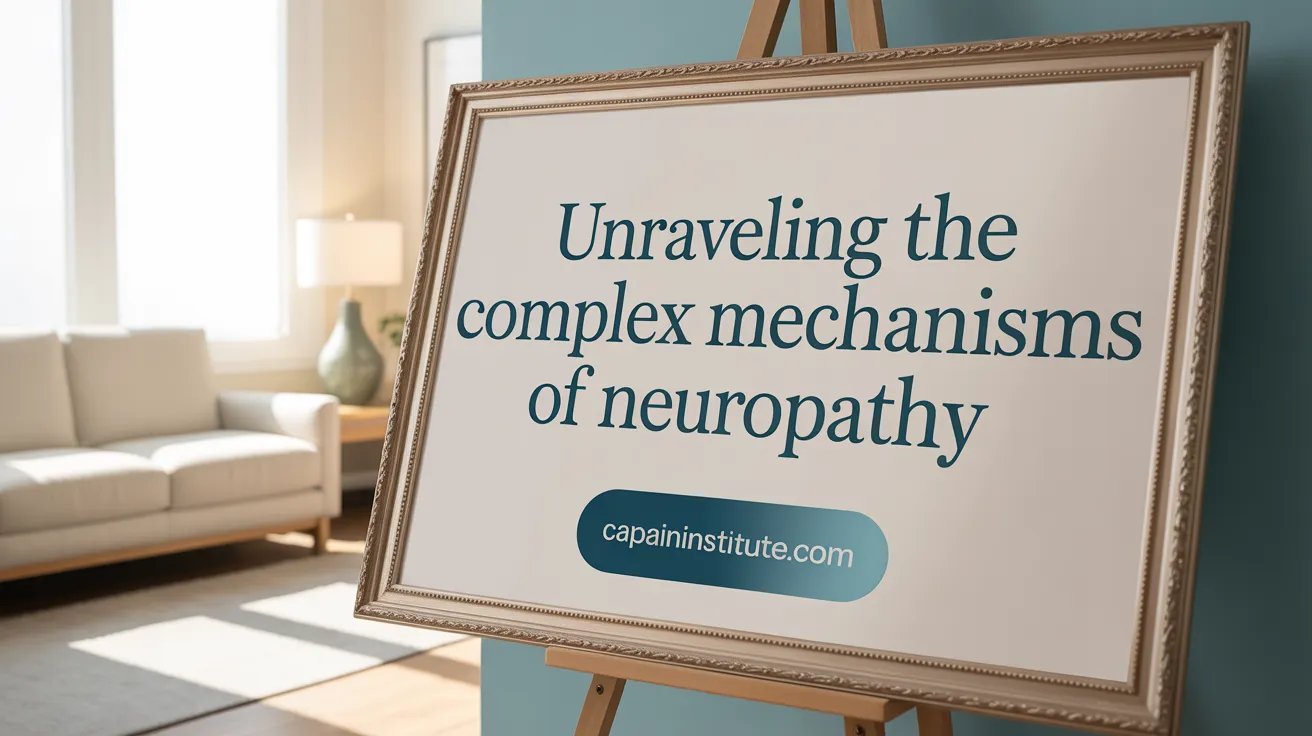Understanding Neuropathy: Scope and Importance
Neuropathy, a condition affecting the peripheral nervous system, leads to symptoms such as pain, numbness, and motor dysfunction. With diverse causes including diabetes, chemotherapy, autoimmune disorders, and genetic factors, neuropathy presents complex challenges for diagnosis and treatment. Recent scientific advancements have dramatically expanded our understanding of neuropathic mechanisms and introduced promising diagnostic and therapeutic approaches. This article delves into cutting-edge research insights and emerging treatment paradigms shaping the future of neuropathy management.
<!-- VIDEO:eyJsaW5rIjoiaHR0cHM6Ly93d3cueW91dHViZS5jb20vd2F0Y2g/dj11SnFTQmNFMzQ1cyIsImltYWdlVXJsIjoiaHR0cHM6Ly9lbmNyeXB0ZWQtdGJuMC5nc3RhdGljLmNvbS9pbWFnZXM/cVxcdTAwM2R0Ym46QU5kOUdjUW1RTm14YVU2LVBlN0M0MERPOVY3SzRJVUViNU9EYjRvSkFQc3hFaUwwM3k4NFxcdTAwMjZzIiwidGl0bGUiOiJGUE4gV2ViaW5hcjogRW1lcmdpbmcgT3B0aW9ucyBmb3IgTmV1cm9wYXRoaWMgUGFpbiAuLi4iLCJzbmlwcGV0IjoiQ29tbWVudHMgwrcgRlBOIFdlYmluYXI6IE5ldyBIb3Jpem9ucyBpbiBDSURQIFRoZXJhcHk6IEV4cGxvcmluZyBDdXJyZW50IGFuZCBGdXR1cmUgVHJlYXRtZW50cyDCtyBQZXJpcGhlcmFsIE5lcnZlIFN0aW11bGF0aW9uIE92ZXJ2aWV3IC0gUmFtYW5hwqAuLi4ifQ== -->Recent Research Findings and Scientific Insights into Neuropathy

What are the recent research findings and scientific insights related to neuropathy?
Recent scientific studies have greatly enhanced our understanding of the complex mechanisms underlying various neuropathies, particularly diabetic peripheral neuropathy (DPN). Researchers have identified that metabolic disturbances, such as hyperglycemia, trigger oxidative stress, inflammation, and damage to small blood vessels supplying nerves, leading to nerve fiber degeneration.
In addition, specific molecular pathways involved in neuropathic pain are being unraveled. The transient receptor potential vanilloid 1 (TRPV1) receptor, which plays a role in pain transmission and inflammation, has been recognized as a significant contributor. Modulating this receptor’s activity offers potential therapeutic avenues.
Novel diagnostic methods are now helping clinicians detect nerve damage earlier and more precisely. Corneal confocal microscopy and skin biopsies allow visualization of small nerve fibers, facilitating early diagnosis of small fiber neuropathy before significant symptoms develop.
Emerging therapeutic strategies are focusing on targeting the molecular and cellular processes involved in nerve injury and repair. Treatments exploring neurotrophic factors aim to support nerve regeneration, while gene therapy and stem cell approaches promise to restore nerve structure and function.
Furthermore, the role of the central nervous system (CNS) in neuropathic pain is gaining attention. Changes in brain structures, such as the thalamus, are associated with pain perception, highlighting the importance of addressing both peripheral and central mechanisms.
The gut microbiota’s influence on nerve health is also under investigation, suggesting that microbiome modulation could become part of future treatment protocols. Overall, interdisciplinary research integrating molecular biology, neuroimaging, and regenerative medicine continues to drive forward the development of more precise and effective therapies for neuropathy.
Causes and Classifications of Neuropathy

What are the causes and classifications of neuropathy?
Neuropathy results from damage or dysfunction in the peripheral nervous system and stems from a wide range of causes. Common factors include systemic conditions like diabetes, which is among the most prevalent, autoimmune diseases, infections such as Lyme disease or shingles, inherited genetic disorders, exposure to toxins, certain medications, trauma, and hereditary conditions like Charcot-Marie-Tooth disease.
The classification of neuropathy can be based on the nerves predominantly affected. These include:
- Motor neuropathy, which impacts muscles, leading to weakness or paralysis.
- Sensory neuropathy, affecting sensation, and manifesting as pain, numbness, tingling, or loss of proprioception.
- Autonomic neuropathy, which influences involuntary functions including heart rate, blood pressure, digestion, and sweating.
- Multiple or mixed neuropathies involve more than one nerve type.
Specific syndromes such as diabetic peripheral neuropathy, amyloid polyneuropathy, inflammatory conditions, and toxic neuropathies are distinguished by their clinical features and underlying causes.
Certain forms of neuropathy are classified as idiopathic, meaning the precise cause cannot be identified despite thorough evaluation. Risk factors include prolonged high blood sugar levels, excessive alcohol intake, nutritional deficiencies (like vitamins B6 and E), and genetic predispositions.
Understanding these classifications is crucial for accurate diagnosis and effective treatment. Tailored approaches focus on managing the underlying condition when identified and alleviating nerve-related symptoms.
By categorizing neuropathy based on nerve type and cause, clinicians can better formulate management strategies and optimize patient outcomes.
| Cause Category | Examples | Impacted Nerve Types | Additional Notes |
|---|---|---|---|
| Systemic Diseases | Diabetes, autoimmune diseases | Sensory, Motor, Autonomic | Diabetes is most common; autoimmune include Guillain-Barré |
| Infections | Lyme disease, HIV, shingles | Sensory, Motor | Infectious causes may trigger immune reactions |
| Inherited Conditions | Charcot-Marie-Tooth disease | Motor, Sensory | Genetic factors often familial |
| Toxins and Drugs | Heavy metals, chemotherapy agents | Sensory, Motor | Neurotoxicity from chemotherapy agents like cisplatin |
| Trauma and Injury | Physical injuries, surgeries | Motor, Sensory | Nerve compression or physical injury |
| Idiopathic | Unknown cause | All nerve types | Most common in older adults |
This classification emphasizes the importance of identifying the precise cause and affected nerves, enabling targeted treatment and management options.
Mechanisms and Pathophysiology Underpinning Neuropathy

What are the mechanisms and pathophysiology of neuropathy?
Neuropathy develops through complex processes involving damage to the peripheral nerves or nerve structures. One primary mechanism is demyelination, where the protective myelin layer around nerves is damaged, often due to autoimmune or inflammatory responses like those seen in Guillain-Barre syndrome. This damage impairs nerve conduction, leading to weakness, numbness, or tingling.
Another common process is axonal degeneration. This occurs when nerve fibers are injured metabolically or toxically, causing the distal parts of nerve axons to deteriorate. Such degeneration is characteristic of diabetic peripheral neuropathy, resulting in sensory loss and pain.
Neuronopathy, involving the degeneration of nerve cell bodies within the dorsal root ganglia or central nervous system, can also contribute to neuropathic symptoms. This affects not just sensory signals but also autonomic functions.
Neuroinflammation plays a critical role in spreading and maintaining nerve damage. Inflammatory mediators activate glial cells within the central nervous system, potentially leading to central sensitization, which amplifies pain signals.
The role of sodium channels, particularly voltage-gated sodium channels, is vital in neuronal excitability. Dysregulation of these channels can lead to hyperexcitability, abnormal firing, and persistent pain. Mitochondrial dysfunction is another key factor, leading to energy deficits within nerve cells, aggravating nerve injury and contributing to neuron dysfunction.
Combinations of these mechanisms underlie the development of neuropathic pain, where abnormal nerve activity, neuroinflammation, and alterations in central pain processing sustain chronic pain states even after the initial nerve injury has occurred.
Understanding these processes is essential for developing targeted therapies that can prevent nerve damage, alleviate symptoms, or potentially reverse nerve injury.
Comprehensive Diagnostic Approaches for Neuropathy

What are the diagnostic approaches for neuropathy?
Diagnosing neuropathy involves a mix of clinical assessment, laboratory testing, and specialized procedures.
Clinicians start with a detailed medical history and physical examination. They look at symptom patterns, such as numbness, tingling, burning, or motor impairments, and note their distribution—whether it's localized or generalized. This helps identify potential causes like diabetes, autoimmune conditions, infections, or genetic factors.
Laboratory investigations play a vital role in uncovering underlying issues. Blood tests can detect blood sugar levels, vitamin deficiencies (like B6 or E), markers of inflammation, or infections such as Lyme disease or HIV.
Electrophysiological studies, including nerve conduction velocity tests and electromyography (EMG), are used to confirm nerve damage. These tests can distinguish between demyelinating and axonal types of neuropathy, aiding in categorization and guiding treatment.
Imaging techniques, especially MRI, assist in complex cases where structural abnormalities or nerve compressions are suspected. For certain neuropathies, nerve or skin biopsies offer direct insight into nerve fiber health, presence of immune infiltrates, or other pathological changes.
Emerging tools include biomarker assessments, genetic testing, and autonomic function evaluation. These advanced diagnostics are particularly useful for atypical or inherited neuropathies.
Overall, a comprehensive approach combining history, clinical examination, laboratory tests, electrophysiology, and imaging allows for accurate diagnosis and tailored treatment strategies.
Current Treatment Options for Neuropathy

What are the current treatment options and emerging therapies for neuropathy?
Managing neuropathy involves a combination of pharmacologic and non-pharmacologic approaches aimed at alleviating symptoms and improving quality of life. Currently, medications such as anticonvulsants like gabapentin and pregabalin are prescribed to reduce nerve excitability. Antidepressants, including duloxetine and tricyclics, are also effective for nerve pain relief. Topical treatments, such as lidocaine patches and capsaicin 8% patches, provide localized pain control and can last for several months.
For cases unresponsive to standard therapies, opioids may be considered, but they come with risks of dependency and side effects. Non-drug interventions are crucial complementary options. Physical therapy helps improve motor function and reduce discomfort, while acupuncture has shown promise in symptom relief and some protective effects.
Lifestyle modifications are essential for managing underlying causes, especially in diabetic neuropathy. Proper foot care, blood sugar control, quitting smoking, and stress management contribute significantly to overall outcomes.
Emerging therapies are promising and include neuromodulation techniques such as spinal cord stimulation (SCS), which has demonstrated in recent trials the potential to drastically reduce pain and restore nerve function. Advanced neuromodulation devices are FDA-approved and used in clinical practice.
Beyond hardware, research is exploring novel pharmacological targets. Studies are investigating drugs that inhibit specific channels like TRPV1 and sodium channels, as well as neuroprotective agents, gene therapy, and stem cell treatments aimed at nerve regeneration.
Novel approaches also involve molecular therapies targeting immune responses, ER stress pathways, and chemokine receptors such as CXCR1/2. These strategies aim to modulate the underlying pathology rather than just manage symptoms.
Additional innovative directions include nanotechnology-based drug delivery systems for targeted treatment, and personalized medicine approaches where therapy is tailored based on individual genetic and biomarker profiles.
In summary, while no cure exists yet, the landscape of neuropathy treatment is expanding rapidly. Combining existing therapies with emerging options and adopting a multidisciplinary, personalized treatment plan holds the best promise for meaningful improvement.
Treatment Advances for Diabetic and Chemotherapy-Induced Peripheral Neuropathy

What are the latest developments in treatment for diabetic and chemotherapy-induced peripheral neuropathy?
Recent research highlights that effective treatments for diabetic peripheral neuropathy (DPN) and chemotherapy-induced peripheral neuropathy (CIPN) remain limited. Currently, duloxetine stands out as the most effective pharmaceutical option for managing CIPN symptoms, offering moderate relief. However, no single agent has proven conclusively capable of preventing neuropathy, though some supplements and antioxidants show promise.
Understanding the mechanisms behind these neuropathies has advanced significantly. For diabetic neuropathy, pathways involving oxidative stress, mitochondrial dysfunction, and inflammation are being explored as potential therapeutic targets. Researchers are also investigating neuroimmune interactions and fatty acid metabolism alterations to understand pain development better.
In CIPN, recent insights point to disruptions in neuronal transport, mitochondrial damage, and neuroinflammatory processes. These discoveries are opening avenues for developing drugs that target these specific pathways. Additionally, novel biomarkers and risk prediction models are under development to identify high-risk patients early and tailor interventions accordingly.
Clinical trials continue to evaluate various therapeutic options. For example, ongoing studies are exploring the use of gene therapy, stem cell approaches, and neuromodulation techniques, like spinal cord stimulation, to improve nerve function and reduce pain. Maintaining good blood glucose regulation in diabetic patients also shows potential in reducing neuropathy risk, though definitive evidence is still being gathered.
Overall, advancements aim to move toward more personalized treatments that target underlying disease mechanisms, rather than just managing symptoms. Researchers hope these efforts will lead to more effective strategies to prevent or slow nerve damage and enhance quality of life for affected individuals.
| Treatment Strategy | Current Status | Future Potential | Key Research Focus |
|---|---|---|---|
| Pharmacological agents | Limited options | Novel drugs targeting specific pathways | Neuroinflammation, mitochondrial protection |
| Supplements & antioxidants | Moderate benefit | Biomarker-guided therapy | Neuroprotective effects, metabolic modulation |
| Interventional therapies | Emerging | Personalized neuromodulation | Spinal cord stimulation, gene therapy |
| Biomarker research | Under development | Early detection, risk prediction | Plasma biomarkers, genetic markers |
| Blood glucose management | Crucial | Potential to prevent progression | Glycemic control impact |
Understanding these areas better could pave the way for breakthroughs in preventing and treating diabetic and chemotherapy-induced peripheral neuropathy.
Innovative Therapies and Emerging Technologies in Neuropathy Management

Stem cell therapies and nerve regeneration
Recent research highlights the potential of mesenchymal stem cells (MSCs) to treat various neuropathies. These cells can promote nerve regeneration, reduce inflammation, and offer neuroprotection, which may help restore nerve function and improve symptoms.
Gene therapy and nanotechnology drug delivery
Emerging approaches like gene therapy aim to modify or correct genetic defects involved in neuropathy. Coupled with nanotechnology-based drug delivery systems, these methods facilitate targeted treatment, increasing efficiency and reducing side effects.
Advanced neuromodulation devices
Technologies such as spinal cord stimulation (SCS) have shown promise in managing painful neuropathy. FDA-cleared devices and new neuromodulation techniques are focusing on altering neural activity to reduce pain and improve sensory function.
Role of robotic and virtual reality rehabilitation
Innovative rehabilitation methods, including robotic-assisted therapy and virtual reality exercises, are improving motor skills and quality of life for neuropathy patients. These tools offer personalized, engaging ways to enhance nerve recovery.
Potential of molecular-targeted drugs
New pharmacological agents that target specific molecules involved in nerve damage—such as chemokine receptors or sodium channels—are under investigation. These targeted drugs aim to halt disease progression and alleviate pain more effectively.
| Therapy Type | Description | Benefits | Future Outlook |
|---|---|---|---|
| Stem cell therapy | Using MSCs for nerve regeneration | Nerve repair, reduced inflammation | Ongoing clinical trials |
| Gene therapy | Genetic modification approaches | Potential disease modification | Early-stage research |
| Nanotechnology drug delivery | Precise targeting of drugs | Increased efficacy, fewer side effects | Emerging technology |
| Neuromodulation devices | Spinal cord stimulation | Pain relief, sensory improvement | Widely adopted in clinics |
| Robotic/VR rehab | Virtual and robotic exercises | Motor recovery, enhanced engagement | Rapid development |
| Molecular drugs | Targeted molecules like sodium channels | Symptom control, disease slowing | Under investigation |
Advances in these therapies demonstrate a promising future for more effective and personalized treatment options in neuropathy management.
Advancements in Neuropathic Pain Understanding and Management

Neuropathic pain pathophysiology and central sensitization
Neuropathic pain stems from damage or dysfunction in the sensory nervous system, resulting in chronic pain that can significantly reduce quality of life. Recent research highlights complex mechanisms involving both peripheral nerve injury and central nervous system changes. Central sensitization, where the brain and spinal cord become hyper-responsive to stimuli, is a crucial contributor. Conditions like diabetic peripheral neuropathy often exhibit cortical plasticity and neuroinflammation, intensifying pain perception.
Role of sodium channels and neuroinflammation
Voltage-gated sodium channels, especially NaV channels, are vital in neuronal excitability. Dysregulation of these channels can lead to hyperexcitability and persistent pain signals. Furthermore, neuroinflammation and glial cell activation amplify pain through cytokine release and immune responses. These processes sustain nerve damage and pain states, making them important targets for novel therapies.
Diagnostic challenges and validated assessment tools
Diagnosing neuropathic pain involves a comprehensive approach with patient history, clinical examination, and specialized tests. Despite the availability of various assessment tools like questionnaires and nerve conduction studies, delays in diagnosis are common. Emerging biomarkers such as neurofilament light (NF-L) levels and imaging techniques including corneal confocal microscopy are aiding earlier and more accurate detection.
Pharmacological and interventional pain management strategies
While no single treatment cures neuropathic pain, multiple strategies have shown moderate success. Pharmacologic options include antidepressants, gabapentinoids, sodium channel blockers, and cannabinoids. Interventional procedures like spinal cord stimulation (SCS) and capsaicin patches also provide relief, especially when medications fall short. Advances like FDA-cleared neuromodulation devices and capsaicin patches demonstrate promising symptom control.
Pain registries and real-world data collection
Developing discussions through pain registries, such as the Greek neuropathic pain registry, offers valuable data on prevalence, treatment efficacy, and gaps in care. These registries help identify suboptimal prescribing practices and underuse of interventional procedures. Collecting real-world data supports improved understanding, guiding personalized treatments and future research in neuropathic pain management.
The Role of Personalized Medicine and Biomarkers in Neuropathy

Use of genetic and biomarker research
Recent advances in genetic and biomarker research are transforming how we understand neuropathies. Whole genome testing helps identify genetic risk factors for conditions like diabetic neuropathy and chemotherapy-induced peripheral neuropathy (CIPN). Biomarkers such as neurofilament light (NF-L) levels are being explored to gauge disease activity, providing potential tools for early diagnosis and monitoring.
Tailoring treatments based on etiology and patient factors
Personalized medicine involves customizing treatment plans based on specific causes and patient characteristics. For instance, autoimmune conditions like neuromyelitis optica spectrum disorder (NMOSD) and myelin oligodendrocyte glycoprotein antibody-associated disease (MOGAD) benefit from therapies targeting underlying immune pathways. Genetic profiles can inform choices of drugs, such as chemokine receptor inhibitors, aiming to improve efficacy and reduce adverse effects.
Autoimmune neuropathies and specialized diagnostics
In autoimmune-related neuropathies, diagnostics are becoming more precise. Techniques like electrochemical conductance testing of hands and feet can detect sudomotor dysfunction, aiding early diagnosis of gluten neuropathy or autoimmune origins. This level of specialization is essential for directing specific interventions, including gluten-free diets or immunomodulatory treatments.
Impact of whole genome and metabolomic studies
Whole genome and metabolomic analyses are uncovering new insights into neuropathy mechanisms. These studies identify genetic modifiers and plasma metabolomic signatures linked to disease severity and pain perception. Such research supports the development of targeted drugs and personalized treatment strategies, ultimately aiming to halt nerve damage or reverse symptoms.
Future prospects for targeted interventions
Looking ahead, the integration of genetic, biomarker, and environmental data will enable personalized medicine to target specific pathways involved in nerve damage, such as oxidative stress, mitochondrial dysfunction, and immune responses. Emerging therapies like gene editing, tailored neuroprotective agents, and advanced neuromodulation hold promise for more effective, individualized management of neuropathies.
Clinical and Lifestyle Strategies to Enhance Neuropathy Outcomes

Importance of early diagnosis and multidisciplinary care
Early detection of neuropathy is crucial for effective management and improving patient quality of life. Diagnostic tools such as nerve conduction studies, skin biopsies, and emerging biomarker tests enable healthcare providers to identify nerve damage at an earlier stage. A multidisciplinary approach—combining neurology, endocrinology, physiotherapy, and mental health support—ensures comprehensive treatment of both the symptoms and underlying causes.
Foot care, exercise, and lifestyle modifications
Proper foot care is essential, especially for diabetic neuropathy patients, to prevent ulcers and infections. Regular foot examinations, proper footwear, and hygiene reduce risks. Incorporating low-impact exercises like walking, yoga, or aquatic therapy enhances circulation and strength, helping maintain motor function. Lifestyle changes—such as a balanced diet, smoking cessation, and alcohol moderation—also play vital roles in controlling disease progression.
Complementary therapies and stress management
Additional therapies like acupuncture and Gosha-jinki-gan (GJG) have been shown to provide symptom relief. Neuromodulation techniques, including spinal cord stimulation and capsaicin patches, offer non-pharmacological options for pain management. Stress reduction practices, such as mindfulness, meditation, and biofeedback, can decrease nerve inflammation and enhance overall well-being.
Patient education and adherence
Educating patients about their condition encourages active participation in management plans. Understanding lifestyle modifications, medication adherence, and proper foot care significantly improves outcomes. Empowered patients are more likely to follow treatment and recognize early warning signs of deterioration.
Healthcare system roles and registry utilization
Creating and maintaining neuropathy registries helps gather vital data on prevalence, treatment efficacy, and gaps in care. Such registries, like the Greek neuropathy database, support research and inform clinical guidelines. Healthcare systems should promote integrated care pathways, support multidisciplinary teams, and leverage technology to optimize diagnosis, treatment, and ongoing monitoring.
| Strategy Category | Specific Approaches | Impact |
|---|---|---|
| Early diagnosis and care | Biomarker testing, neurological exams | Speeds up detection, improves targeted treatment |
| Lifestyle and foot health | Exercise, foot care routines | Prevents complications, enhances mobility |
| Complementary and non-pharmacologic | Acupuncture, neuromodulation, stress techniques | Symptom relief, reduces reliance on medications |
| Education and adherence | Patient counseling, instructional materials | Better treatment compliance, quality of life improvements |
| Healthcare infrastructure and data use | Registries, multidisciplinary teams, AI tools | Data-driven care, personalized treatment planning |
Looking Ahead: The Future of Neuropathy Care
The evolving landscape of neuropathy research and treatment offers renewed hope for millions affected worldwide. With advances in understanding complex pathophysiological mechanisms, novel diagnostic modalities, and the emergence of innovative therapies—from stem cells to neuromodulation—personalized and more effective management is within reach. Ongoing clinical trials and real-world data collection initiatives remain crucial for translating scientific breakthroughs into tangible health benefits. Multidisciplinary approaches combining pharmacologic, rehabilitative, and lifestyle interventions will be essential to optimize outcomes. As research continues to unravel neuropathy’s mysteries, the future promises earlier detection, targeted treatments, and improved quality of life for patients globally.
References
- New Insights into Potential Prevention and Management ...
- Latest Treatments for Neuropathy: Exploration & Study ...
- What's New in Neuropathy? - PMC
- Latest Medical Advances in Peripheral Neuropathy
- Diabetic neuropathy: cutting-edge research and future ...
- Understanding Neuropathy: Causes, Treatments, and New ...
- Peripheral neuropathy - Diagnosis and treatment
- Current Research
- Editorial: Insights in neuropathic pain: 2022
